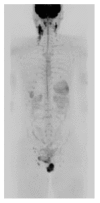Secondary Syphilis with Tonsillar and Cervical Lymphadenopathy and a Pulmonary Lesion Mimicking Malignant Lymphoma
- PMID: 29502129
- PMCID: PMC5846205
- DOI: 10.12659/ajcr.907127
Secondary Syphilis with Tonsillar and Cervical Lymphadenopathy and a Pulmonary Lesion Mimicking Malignant Lymphoma
Abstract
BACKGROUND Syphilis is a sexually transmitted disease caused by the pathogen Treponema pallidum. Prevalence continues to rise, especially among men who have sex with men (MSM). Due to changes in patterns of sexual activity, manifestations of the disease are highly variable. CASE REPORT A 27-year-old male visited the hospital for a low-grade fever and tender 5-cm mass in the right side of his neck. His right tonsil was swollen and covered with a white coating. Levofloxacin was prescribed, but ineffective. The patient's levels of liver function enzymes increased gradually. Systemic magnetic resonance imaging (MRI) revealed bilateral cervical lymphadenopathy with right predominance, a right pulmonary nodule, and a periportal lymph node, suggestive of malignant lymphoma. However, a biopsy of the right cervical lymph node showed nonspecific inflammation. Preoperative rapid plasma reagin (RPR) and T. pallidum latex agglutination (TPLA) tests were positive. The patient was MSM and reported oral sex with many sexual partners. A diagnosis of secondary syphilis was made. Oral amoxicillin was effective, and all symptoms other than periportal lymph node resolved. CONCLUSIONS Tonsillitis, cervical lymphadenopathy, and lung lesions can be manifestations of secondary syphilis. A detailed history, pathology, and serology are crucial for diagnosis.
Conflict of interest statement
None.
Figures



References
-
- Hook EWR. Syphilis. Lancet. 2017;389(10078):1550–57. - PubMed
-
- Gulland A. Number of cases of syphilis continue to rise. BMJ. 2017;357:j2807. - PubMed
-
- Cerchione C, Maraolo AE, Marano L, et al. Secondary syphilis mimicking malignancy: A case report and review of literature. J Infect Chemother. 2017;23(8):576–78. - PubMed
-
- Fu Z, Zhang J, Li Q, et al. A case of secondary syphilis involving tonsil, pulmonary, and multiple lymph nodes: 18F-FDG PET/CT findings. Clin Nucl Med. 2015;40(4):335–37. - PubMed
Publication types
MeSH terms
Substances
Supplementary concepts
LinkOut - more resources
Full Text Sources
Medical

